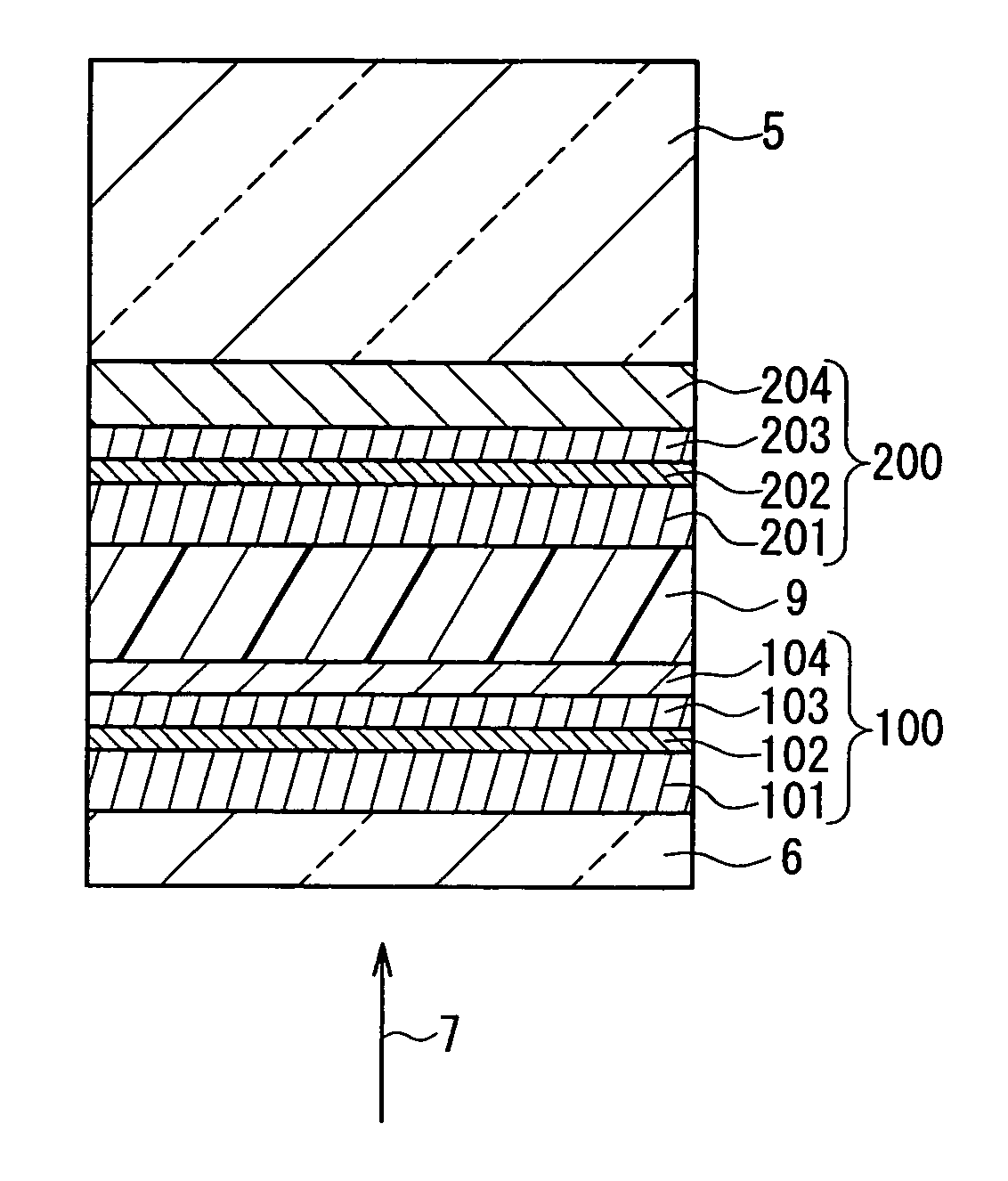Optical information recording medium
- Summary
- Abstract
- Description
- Claims
- Application Information
AI Technical Summary
Benefits of technology
Problems solved by technology
Method used
Image
Examples
example 1
[0069]In Example 1, an optical information recording medium was produced that had a configuration shown in FIG. 1. A disc-like polycarbonate plate was used as the substrate 5. The disc-like polycarbonate plate had a thickness of 1.1 mm and a diameter of 120 mm. It had a spiral groove formed on a surface thereof. The spiral groove had a width of 0.25 μm, a pitch of 0.32 μm, and a depth of 20 nm. A mixture of 80 mol % of ZnS and 20 mol % of SiO2 (hereinafter referred to as “(ZnS)80(SiO2)20 (mol %)”, and the same applies to other mixtures) was used for the first protective layer 1. A mixture, (ZrSiO4)90(Cr2O3)10 (mol %) was used for the second protective layer 3. A mixture, Al98Cr2 (atomic %) was used for the reflective layer 4. A mixture, Te43O50Pd7 (atomic %) was used for the recording layer 2. The first protective layer 1 and the second protective layer 3 had a thickness of 6 nm and a thickness of 17 nm, respectively. The reflective layer 4 and the recording layer 2 had a thickness ...
example 2
[0082]An optical information recording medium having a configuration shown in FIG. 5 was produced as another example. The substrate 5 shown in FIG. 5 was the same as that of the medium (1) described in Example 1. The reflective layers 104 and 204 were formed of Ag—Pd—Cu and Al—Cr, respectively. The recording layers 102 and 202 were formed of Te50O25Pd25 (atomic %) and (Te50O25Pd25)95(SiO2)5 (mol %), respectively. All the first protective layers 101 and 201 and the second protective layer 203 were formed of (ZnS)80(SiO2)20 (mol %). The second protective layer 103 was formed of (ZrSiO4)30(Cr2O3)40(LaF3)30 (mol %). The refractive index of the (ZrSiO4)30(Cr2O3)40(LaF3)30 (mol %) at the wavelength of 405 nm is 2.0, which is smaller than the refractive index of the (ZnS)80(SiO2)20 (mol %), namely 2.3. That is, the first information layer 100 employed the configuration of the information layer of the optical information recording medium according to the present invention.
[0083]Thickness of...
example 3
[0088]An optical information recording medium having four information layers shown in FIG. 7 was produced as another example.
[0089]First, the procedure for producing the optical information recording medium of the present example is described. The respective layers of the fourth information layer 400 were formed on the grooved surface of the substrate 5 sequentially from the reflective layer 404 to the first protective layer 401. Subsequently, an ultraviolet curable resin was applied thereto as the intermediate layer 9 and the same groove as that of the substrate 5 was formed at its surface by printing. Thereafter, the respective layers of the third information layer 300 were formed on the grooved surface of the intermediate layer 9 sequentially from the reflective layer 304 to the first protective layer 301. Then an ultraviolet curable resin was applied thereto as the intermediate layer 9 and the same groove as that of the substrate 5 was formed at its surface by printing. Subseque...
PUM
| Property | Measurement | Unit |
|---|---|---|
| Thickness | aaaaa | aaaaa |
| Transmittivity | aaaaa | aaaaa |
| Metallic bond | aaaaa | aaaaa |
Abstract
Description
Claims
Application Information
 Login to View More
Login to View More - R&D
- Intellectual Property
- Life Sciences
- Materials
- Tech Scout
- Unparalleled Data Quality
- Higher Quality Content
- 60% Fewer Hallucinations
Browse by: Latest US Patents, China's latest patents, Technical Efficacy Thesaurus, Application Domain, Technology Topic, Popular Technical Reports.
© 2025 PatSnap. All rights reserved.Legal|Privacy policy|Modern Slavery Act Transparency Statement|Sitemap|About US| Contact US: help@patsnap.com



